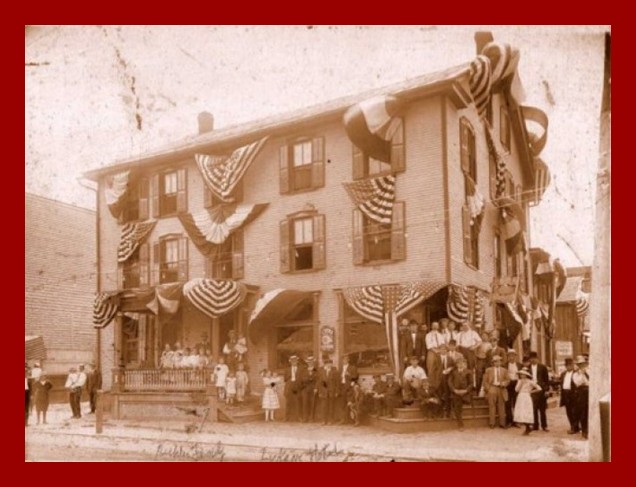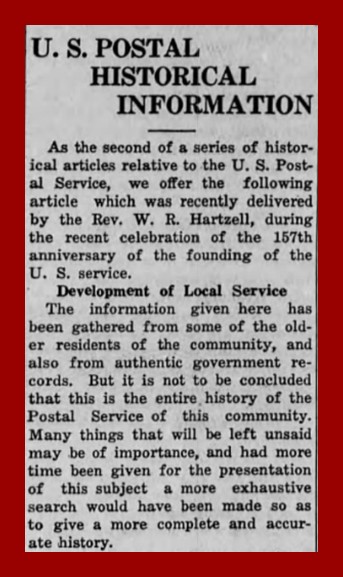
The first post office in Lykens, Dauphin County, Pennsylvania, was established in 1857 on Main Street, in a building known as “ten pin alley,” which was located just to the east of the Union House located on the southeast corner of Main Street and Market Street. At the time the above photo of the Union House was taken, the first post office building had long been demolished and the area where the building was located was an empty lot (to the left of the Union House in the photo above).
A brief item in the Lykens Register of July 4, 1873, told of the “pulling down:”
The small building which belonged to the Union House property in this borough occupied years ago by a printing office, ten-pin alley [bowling], etc., and for several years past by Shaud’s boot and shoe store, was pulled down this week. Mr. Byerly will appreciate the ground occupied by the building to enlarging the hotel yard.
Today, the old Lykens Hotel occupies this site. The building was completely renovated and opened as the Union House Apartments in 2015.

On August 12, 1932, the Lykens Standard published an article on the history of the Local postal service. The article described the way the mail was carried from one place to another and told of the establishment of the post offices at Wiconisco and Lykens, with a listing of postmasters at both places. Some of the information presented in the article needs further verification and should be used with caution.
U. S. POSTAL HISTORICAL INFORMATION
As the second of a series of historical articles relative to the U. S. Postal Service, we offer the following article which was recently delivered by the Rev. W. R. Hartzell, during the recent celebration of the 157th anniversary of the founding of the U. S. service.
Development of Local Service
The information given here has been gathered from some of the older residents of the community, and also from authentic government records. But it is not to be concluded that this is the entire history of the Postal Service of this community. Many things that will be left unsaid may be of importance, and had more time been given for the presentation of this subject a more exhaustive search would have been made so as to give a more complete and accurate history….
Lykens was laid out in the year 1847; Wiconisco, Bear Gap, in 1848, and Gratz in 1828. Coal was discovered here in 1828 and the railroad was built in 1847. The people of Lykens received their mail from Gratz which was carried across Short Mountain on foot, and this was a time when not even roadways were in poor condition, but even foot-paths. Storms were even more severe than at present.
It might be of interest to note that there were no Postage Stamps used in these early day. The one who would mail the letter would expect the recipient to pay for the carriage when he received it. It was not until many years later that the sender of a letter paid the postage in advance. In 1826 when one wished to send a letter to Philadelphia he used no stamp, but shipped it by boat on what were called packet-boats.
The postage rate for letters of the first class was three cents up to 1882, after which it dropped to the two-cent rate. Today it returned to the three-cent rate, and evidently the stamping act has come to stay.
In 1848, the mail was carried on horseback from Tremont, down the Williams Valley to Millersburg, and thence up the Lykens Valley to Tremont. The route was followed three times a week. in 1866 there was a daily stage coach between Tremont and Tower City. The railroad also assisted in carrying mail about this time.
Apparently Wiconisco received service by these early methods also, and in 1866 and for several years later the mail was carried by men between Lykens and Wiconisco. For a time the Pennsylvania Railroad train stopped at the crossing in Wiconisco and Mr. William Rowe carried the mail from there to the post office. Later on, and up to the present time [1932] the mail has been carried by truck and bus. Wiconisco post office was changed from fourth class to third class in the year 1920 on November 8.
Lykens post office was established in the year 1857 with the first post office located east of the Union House, now Hotel Lykens, and was known as “Ten Pin Alley.” But we moderns call such a building a “Bowling Alley.” The office was later placed across the street on the site now occupied by Brenner’s store. Next it was located at the Stewart Building on the southwest corner of Main Street and Pine Street. Later it was moved to the northeast corner of Main and Market Streets. Thence it was moved into the Young Building, now [1932] the Weaver Art and Gift Shop, Market Street. From here it was placed in the building now used by Dr. George Myers, Market Street below North Second Street.
Again it was located in its former place where Brenner’s store is now located, on Main Street. It was then changed to its present site in Main Street.
The Lykens office issued its first Money Order on July 14, 1873. The post office was changed from fourth class to third class on January 1, 1893, and from third class to second class on July 1, 1924. Village delivery was established April 1, 1920, and city delivery on April 1, 1929.
The Rural Service began with the Gratz Post Office and served the community North, North East, and South East of Gratz. In October 1919 the Rural service Route started from the Loyalton post office and included the Gratz Route. On April 1, 1920 the rural service went out from the Lykens post office and included the entire territory formerly served. The same is the present service rendered.
The postmasters who served at Wiconisco are as follows: Henry Shaeffer, 1854; David Smith; John Kauffman; Jacob S. Prout; Lewis M. Neiffer; George A. Pinkerton; Michael Hensel; E. LeRoy Keen; and George S. J. Keen, the present postmaster.
The postmasters who served at Lykens, together with date of appointment are as follows: Josiah Bowman Jr., January 28, 1857; Jonas Garman, May 4, 1861; Josiah Bowman, October 17, 1866; R. G. Stewart, May 10, 1869; John L. Shaud, December 3, 1877; W. S. Young, June 29, 1880; Henry K. Myers, January 7, 1886; Jacob Alvord, August 9, 1889; M. F. Moyer, January 28, 1897; Henry Feindt, February 8, 1901; Charles A. Hoff, January 18, 1913; and C. W. Keiser, January 8, 1924, the present time.
____________________________________________________
News article from Newspapers.com.
Corrections and additional information should be added as comments to this post.